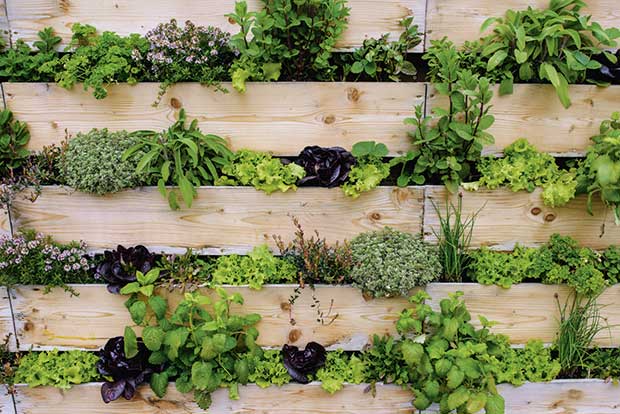
Vertical planting can substantially increase the growing area in a small garden or roof terrace. For the grow-your-own enthusiast, herbs, vegetables and small fruit such as strawberries thrive, offering a year-round harvest.
A few things to keep in mind when growing vertically:
1. Vertical planters require as much attention as any garden, with regular watering, weeding, pest control, feeding and trimming
2. Many planters dry out quickly; regular watering is important. Most vertical gardens require watering at least twice a day for 1-2 minutes. Equally, be cautious not to over water – if drainage is inadequate, soggy roots will soon become sickly roots.
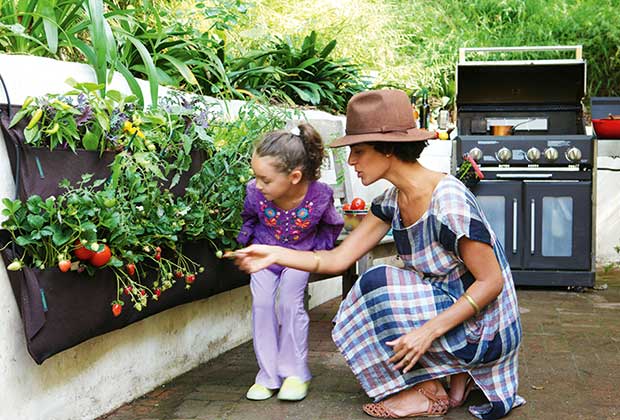
3. To make sure plants get the necessary nutrients, add fertiliser to the water, or slow-release fertiliser to the soil
4. Vertical gardens are heavy, and some walls may not be strong enough to support one. Check with a carpenter, engineer or your landlord to make sure the designated wall can handle the load.
5. When choosing a spot for your living wall, ensure the area gets plenty of light, but not direct, all-day sun
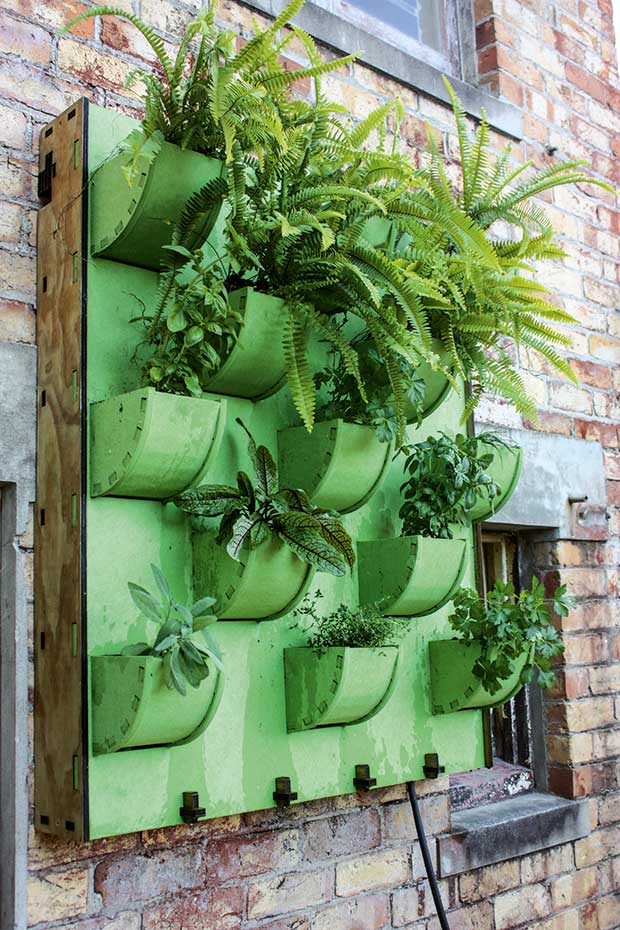
This heavy-duty modular living wall with built-in irrigation measures 1.2m high x 1m wide x 0.3m-deep panels that can be hung vertically or horizontally. Visit Living Urbanism.
6. Each growing wall has different requirements, depending on the amount of light it receives. Talk to a local nursery about plants that suit your conditions.
GOING UP
Confident DIYers can design and build their own living walls. Key considerations are building a strong, sturdy structure to support planters, using untreated timber if growing edibles, and providing appropriate drainage and irrigation. Customising will give you the growing edge.
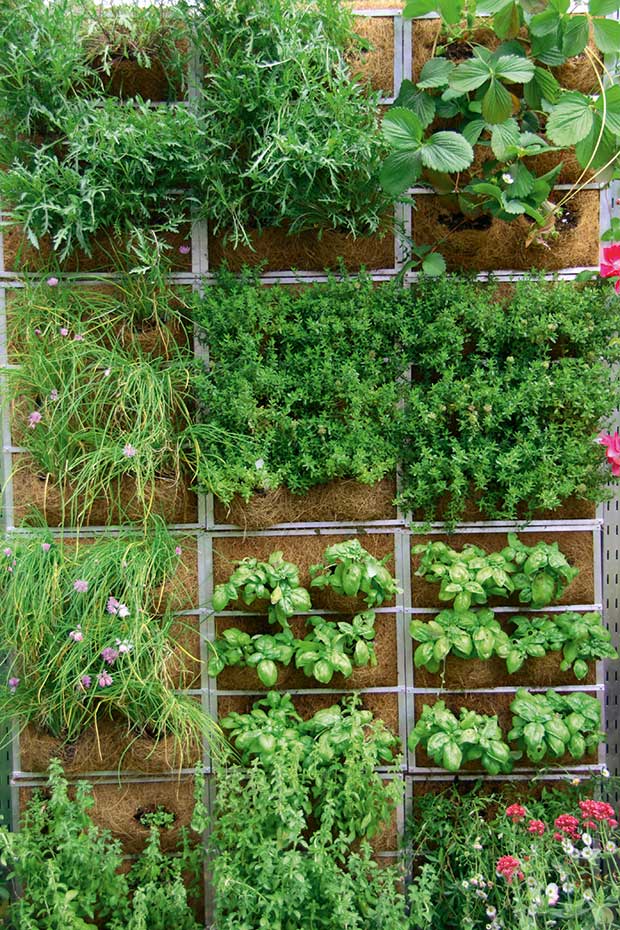
Grow sun-loving plants at the top of a living wall where they can soak up all the light they need to thrive. Scale down according to a plant’s light requirements.
WIND FACTOR
Wind significantly increases the rate of evapotranspiration – water evaporation and plant transpiration.
Choose a location with some shelter from strong winds or choose plants that cope with evapotranspiration, such as thyme, rosemary, oregano, sage and thick-leaf greens such as kale and miner’s lettuce.
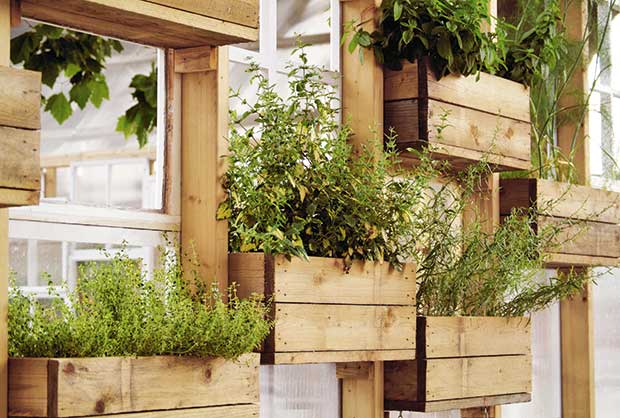
LIGHT AND BRIGHT
Be aware of how much sunlight your crop needs and where it can be best located. A built-up area shaded by surrounding buildings suits leafy vegetables, such as lettuce, cabbage and greens.
Sun radiated by concrete or reflected by a bright wall creates hotter and brighter conditions than full sun. Vegetables that like full sun include tomatoes, peppers, potatoes, beans, carrots and radishes.
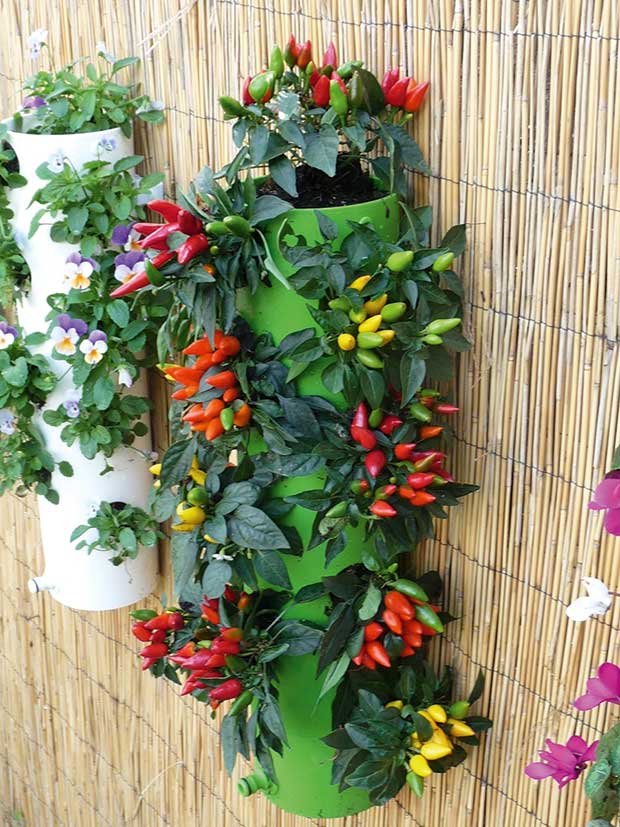
The ‘Polanter’ has an integrated watering system and can be fixed to walls, fences and windowsills. Available from hardware stores.
Light availability differs within a vertical garden, with plants at the top providing shade for their more sun-sensitive neighbours. Grow sun-loving plants such as creeping nasturtium at the top tier, where they can soak up bright, hot sun and grow to provide shade to other plants. Like a natural cliff environment, plants will create their own microclimate.
A north or east-facing location, or something in between, usually produces the happiest plants.
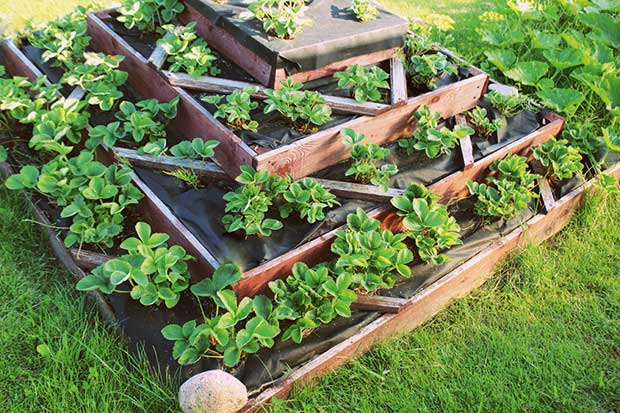
Unless you choose shade-loving plants, areas shaded by a building or wall to the south will not get enough sun to foster healthy plant growth, and west-facing positions, especially on a building, can be too intense.
More stories you might like:
Trading London life for paddock-to-plate success at Waipu’s Cove restaurant and bar
CLIMBERS
Climbing plants offer a logical choice in vertical gardens; suitable vegetables include climbing beans and peas, kumara, vining tomatoes and sprawling courgette, cucumber, melon and squash that can be trained to grow up supports.
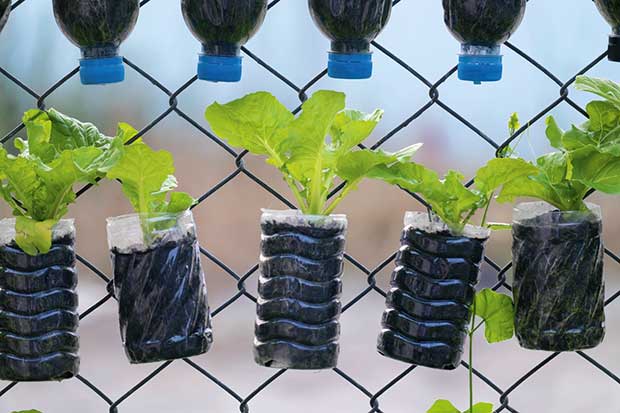
Save plastic bottles, containers and tins to plant up with herbs and greens, then hang them in a suitably sunny spot.
Trellises can be used to support trailing or vine crops. Fences serve well as a trellis for beans, peas, tomatoes and vine crops such as squash and cucumbers. Using corn stalks or sunflowers is another great way to take advantage of vertical space, while making interesting supports for beans and other climbing vegetables.
Cane fruits such as raspberries and blackberries naturally grow tall. If left unsupported, the canes have a habit of flopping over to smother neighbouring crops, but parallel wires will keep them growing vertically.
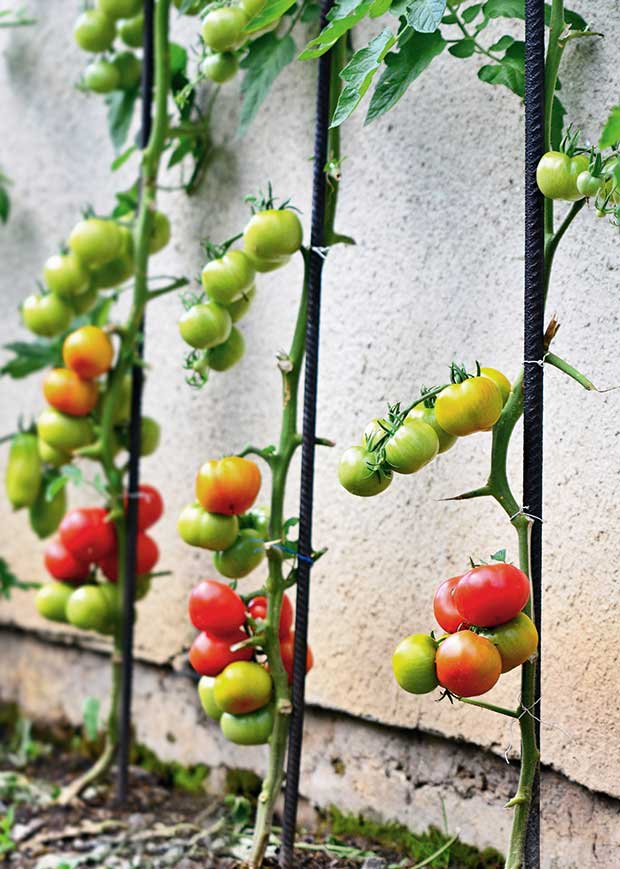
Make use of every growing inch available. Don’t be deflated if you don’t get a bumper crop the first time around – note what does well and where and keep trying.
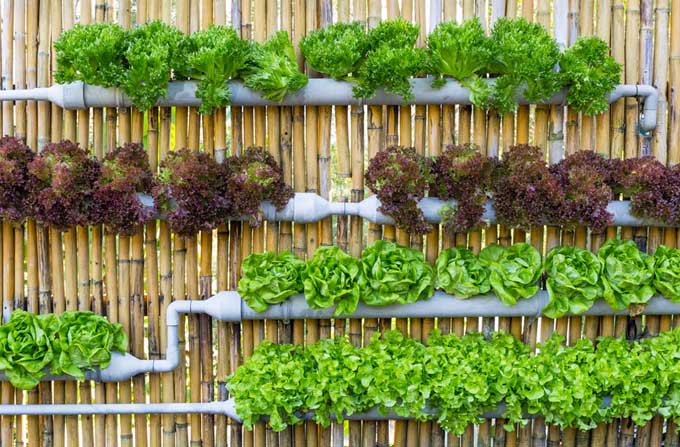
Feed Yourself and Feed Your Neighbors Too
We live in a time where people are beginning to take a second look at growing their own food. Raising your own produce saves money at the grocery store, having fresh produce at hand is convenient, you know exactly what was and wasn’t sprayed on the food you are about to eat and gardening can be very therapeutic for us as well.
For centuries people in the United States grew their own fruits and vegetables. This allowed us to spend less money at the store (if they even existed) and more time at home.
Think about how much of your time is spent at work and how much of that money earned is going toward your produce. Could you work less if you spent less? For most people, that answer is yes.
Taking a step toward self-sufficiency begins with gardening. It also makes sense that if you are growing your own fruits and vegetables to save yourself some time and money, you will want to get the most out of your garden without spending all of your time taking care of it.
You may benefit from growing your plants vertically and it is my personal opinion that everyone would choose to if they knew and understood more about it.
The Concept of Vertical Gardening
Vertical gardening produces a great deal of food in a very small space. There are hundreds of things that can be grown vertically that will yield large crops from just a few square feet of space.
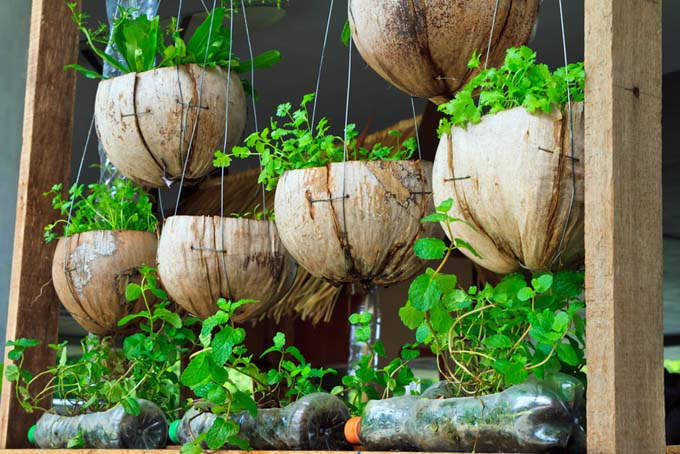
To begin with, you must lose your vision of gardening in rows. Vertical planting is done in block areas or even in pots or small, raised beds. Do you enjoy weeding? Most people don’t!
By planting a garden that grows upwards, dealing with weeds becomes a thing of the past. The time saved in weed control is only one of the benefits.
By not having all of the leaves and vegetable growth on the ground, pest control is also much easier. Growing your own food also means that you have control over the type of pest control that is used. Choosing natural options makes for healthier living.
This type of gardening also requires less water. You typically are using containers or raised beds, which do not allow the precious water to leech out into the rows between planted items like in a typical garden.
Plants such as strawberries, lettuces, peppers, carrots and the like can be planted in containers that are stackable. You can purchase pots like these or create your own step-style containers for these items.
Again, this allows you to grow far more in much less space than if you were planting traditional rows.
The first thing that you want to do is decide what you’d like to plant. Tomatoes are a very popular choice because so much can be made from the delightful fruits.
Imagine being able to create your own pasta sauces, soups with stewed tomatoes and fresh tomatoes on summer salads. Tomatoes are also relatively easy to can, if you’d like to save your summer crops for winter goodies.
To keep your garden as organic as possible, choose heirloom seeds that are labeled “Non-GMO” so that you know you are starting with seeds that have not been genetically altered in any way.
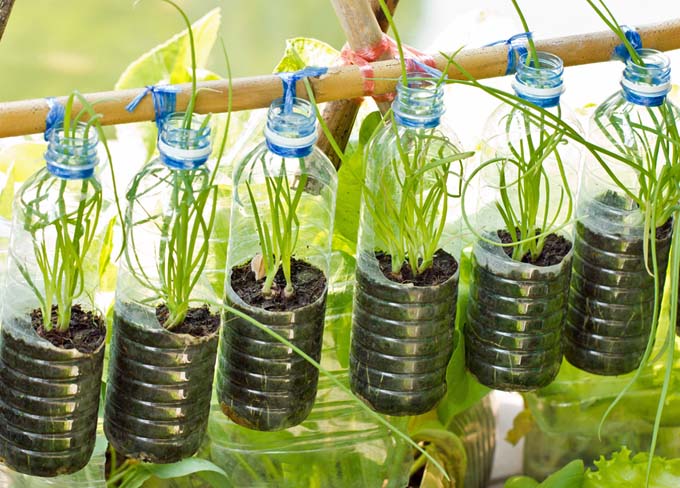
You can utilize pots to grow tomatoes and many other varieties of plants. I know someone who grew over twenty pounds of potatoes in a simple, five gallon bucket. Carrots are another great possibility. You are only limited by your imagination!
To add something to containers for your plants to climb on, get creative. Old objects that can be recycled from around the house are perfect.
Old wire hangers can be used to create twisted, artistic creations that add to the look of your pots and give your vines something to grow on.
For large pots, you can get very creative. I’ve seen people use old toys that their children have outgrown to create whimsical container gardens. Again, use your imagination because vines will crawl up most anything. The higher it can climb, the more food it will yield.
Growing your vegetable crops in containers a great choice if you live in an apartment. Beans, potatoes, carrots, tomatoes, cucumbers, strawberries and much more will thrive in containers.
All you need is a place where adequate sunlight can be found. Think about areas on patios, steps, in windows, on decks and even on rooftops of apartment buildings.
For vertical gardening outside, the sky is the limit! For an outdoor garden of this type, not much space is needed. Pots can be utilized, raised beds are an excellent choice and typical growing locations in your yard is all completely fair game.
By planting in square grids and leaving yourself space to walk and move through the plantings, you will find it easier to maintain and there will be far less weeding.
For outdoor gardening, one of my favorite ideas is to use old pallets. Many feed stores give them away. It isn’t hard to find pallets, once you start looking for them.

Laying down a barrier of some sort under the pallets, like some old newspapers, will provide a weed barrier and compost too. You will have no need to weed.
Lay the pallets down on top of your barrier, one to two thick depending on the things you are planting, then fill them with good soil. Potting soil can be purchased in bags or you can have a truck deliver a load of good topsoil for you.
Now you have perfect little rows with no weeds to worry about. When the season is done, the pallets can be removed and the soil can be set aside and worked for next year, with a little upkeep and composting.
Pallets can be stood on end, or leaned together a-frame style. By adding some simple hinges to a couple of pallets, you can stand them up in varying patterns and use them year after year.
The beauty of this is that it grows up to heights that make it easy for people to take care of. If you are wheelchair bound or have a very bad back, this makes it possible for you to reach your crop without stooping and bending.
By allowing your plants to grow up instead of spreading on the ground, they have far more room to produce vegetables. You can easily triple the amount of produce you harvest from the same amount of seeds.
A good example is green beans. If allowed to grow upwards, rather than crawling on the ground, some varieties will grow over five feet tall!
Pole beans will continue to add new growth all season long, so you will have more beans than you can probably eat from just a two foot square of ground space.
Other Ideas…
You can get very creative with the space used for your garden. If you have fences, consider hanging baskets of plants all over your fence. Go to mobile home dealers and ask them for any old steps they have.

In many cases, they have some that the wooden steps have rotted and fallen from. Add a couple of new boards and you’ll have some excellent plant shelves.
Old chairs can be used to allow plants to climb on, hang baskets from the back and s place pot in the seat. You can grow three things on that old chair in the space of less than two cubic feet.
Some great places to seek ideas on container and vertical growing are Pinterest, Facebook and YouTube. Remember that the last big advantage of growing in your own space is the satisfaction you receive.
Considerations of Small Spaces
If you are going to do some vegetable gardening using containers, tables, planters, or bags, and you don’t have a ton of space to work with, here are some things to consider:
Maximize Sunlight: With small spaces, particularly balconies, plants can suffer from a lack of light. There are ways to deal with this, primarily by noticing where the light comes from and maximizing it. If you need to vertically stack your grow containers, be sure that the shadow of the top one doesn’t block light to those underneath.
With extremely limited space and light, a pallet garden might be the perfect idea for you. (They’re better for herbs than veggies).
Presentation Is Key: A container-style garden is a good idea for a patio, but only if it doesn’t make your outdoor space unmanageable. You still need access to the space, and there’s no reason it should feel cluttered. (In a moment, I’ll go over some wonderful planters and configurations to make sure your little garden is nicely presented and easy to maintain and enjoy.)
Weight Restrictions: Garden containers can be pretty heavy, which is an important consideration for anyone hoping to put one on a balcony. Be sure that you don’t exceed the weight restrictions of your balcony or deck.
Potato barrels, for example, can weigh hundreds of pounds when watered. It normally isn’t an issue unless you’re trying to start a high-yield hobby farm on your balcony.

Table Planters: Easy, Attractive, and Accessible
No dirt? No problem! A clever and well-made table planter is an apartment gardener’s dream! It provides a good amount of soil and fits on your balcony.
The nice thing about a raised bed is that it really works. You’ve got a good amount of space to work with, so you can have a good amount of dirt in the planter itself. It can even be built waist high, which means you don’t have to bend down and hurt your back when you’re tending to it.
It has at least 11 inches of depth for your soil, so you have access to about 8 cubic feet to plant in! That’s quite a bit. It’s not really enough to grow potatoes in, but it’s considerable all the same. Tomatoes, lettuce, and zucchini should all do well.
Here’s a table-style planter that I really like, and that should work really well on a deck or balcony. It’s a patio herb and vegetable garden that is well made and good looking, made from natural cedar. Definitely worth a look! Or you can build your own. Either way, it’s a pretty ideal system.
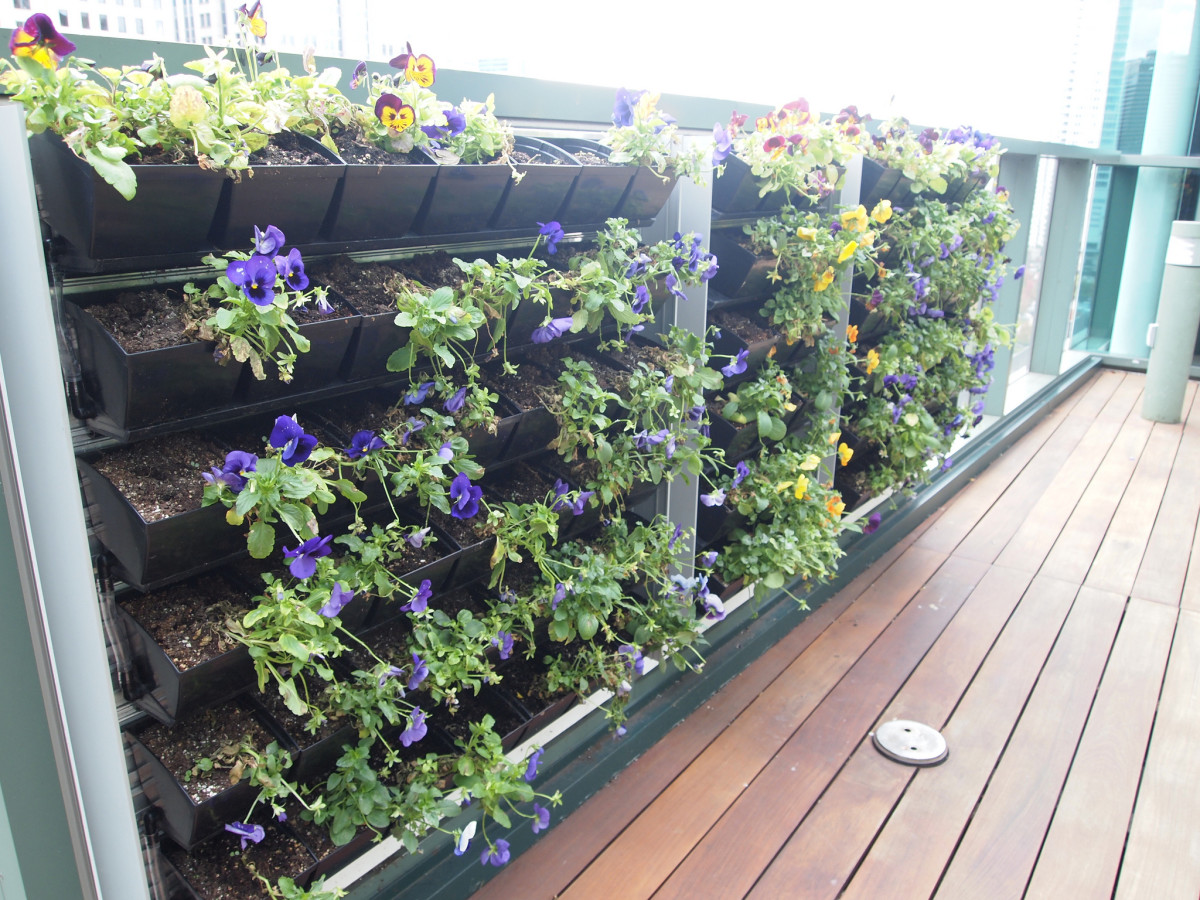
Vertical Planters: The Ultimate Space-Saver
Remember the issues I mentioned with small spaces and lack of light? Here is a great solution! A vertical planter is ideal for a wide variety of herbs and vegetables. They minimize the space requirements while maximizing veggie output, and perhaps most importantly, they look amazing.
This is a very similar idea to pallet gardening, in that it’s intended to lean up against a wall. The advantage here is that it’s much more well built than a pallet, and it looks a lot better and more “refined.”
These can be made in natural cedar that will age nicely on your patio or deck. It’s pretty versatile, boasting many tiers and a “penthouse” top shelf for plants that need more sun.
It also enables a drip irrigation system, meaning that you don’t have to water each tier. Just water the top, and it will trickle down to each plant. That’s a nice thing because it avoids root rot, too.
This style of planter is definitely intended for plants that don’t require too much soil. Lettuce, basil, parsley, and oregano would do extremely well here. Tomatoes could grow here too, but be warned that tomato roots are aggressive and will overtake other plants.
On the whole, this is a well-thought-out solution for apartments, patios, and decks. Here’s a nice vertical-style balcony planter that separates each plant into its own compartment. It’s really good for aggressive herbs like mint and oregano because their roots won’t compete.

Strawberry planters are ideal for maximizing space.
Multi-Tiered Pots: Grow Lots of Different Things at Once
If you don’t have a lot of square footage, you need to be creative with what you have. That’s why stackable planter pots make plenty of sense. As with the vertical planter, you’re making use of that underutilized vertical square footage.
That’s where this little planter shines. It’s intended for growing strawberries, but it’s actually ideal for a number of different types of plants.
It features a number of space-saving advantages: It can either sit on the ground or hang from a chain, and it allows a flow-through irrigation system that lets you water the system only once, rather than having to water each plant pod individually.
It allows plants to grow vertically. The planting spots are not huge, so don’t expect to grow potatoes or carrots in them, but they’re a good size for most herbs, cherry tomatoes, strawberries, and other similar vegetables and fruits.
If you get tired of growing vegetables in it, feel free to switch over to flowers.

Potato Bags: Perfect for Growing Spuds and Root Vegetables
Potatoes traditionally require a good amount of soil because they’re a root vegetable— that makes veggie gardening tricky on a balcony. However, a potato bag like this one is a good way to give them the soil they need.
Conceptually, it’s wonderfully simple. The bags are made of a felt-like material that is light and flexible, yet strong enough to hold in the dirt and plant. The fabric is breathable and porous, so the roots are aerated, and the soil temperature is more conducive to growth. The material also allows excess water to escape, which prevents overwatering.
Note: If you’re growing on a balcony, be aware that these bags leak! They’re meant to. If that’s a problem, you’re better off putting the bag inside of a waterproof container. For places where the ground can get wet, you’re fine to just grow the potatoes or carrots in the bag and let the water leak out.
Even on a balcony, deck, or patio veggie garden, you’ll get a good yield of potatoes with these inexpensive, light, smart, and reusable bag planters.
